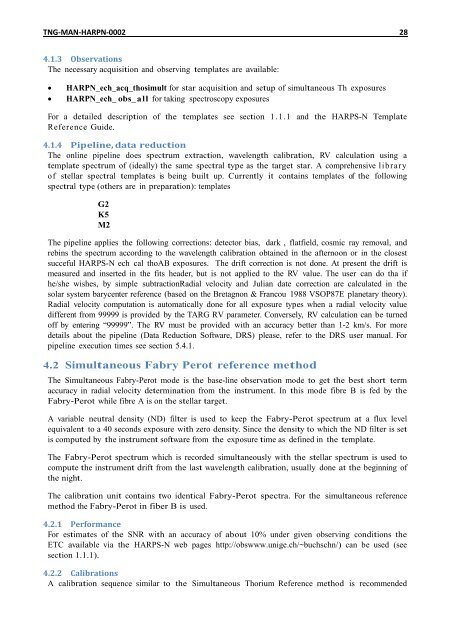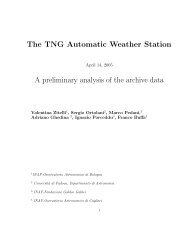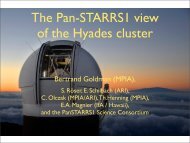HARPS-N USER MANUAL
HARPS-N USER MANUAL - Telescopio Nazionale Galileo
HARPS-N USER MANUAL - Telescopio Nazionale Galileo
- No tags were found...
Create successful ePaper yourself
Turn your PDF publications into a flip-book with our unique Google optimized e-Paper software.
TNG-MAN-HARPN-0002 28<br />
4.1.3 Observations<br />
The necessary acquisition and observing templates are available:<br />
<br />
<br />
HARPN_ech_acq_thosimult for star acquisition and setup of simultaneous Th exposures<br />
HARPN_ech_ obs_all for taking spectroscopy exposures<br />
For a detailed description of the templates see section 1.1.1 and the <strong>HARPS</strong>-N Template<br />
Reference Guide.<br />
4.1.4 Pipeline, data reduction<br />
The online pipeline does spectrum extraction, wavelength calibration, RV calculation using a<br />
template spectrum of (ideally) the same spectral type as the target star. A comprehensive library<br />
of stellar spectral templates is being built up. Currently it contains templates of the following<br />
spectral type (others are in preparation): templates<br />
G2<br />
K5<br />
M2<br />
The pipeline applies the following corrections: detector bias, dark , flatfield, cosmic ray removal, and<br />
rebins the spectrum according to the wavelength calibration obtained in the afternoon or in the closest<br />
succeful <strong>HARPS</strong>-N ech cal thoAB exposures. The drift correction is not done. At present the drift is<br />
measured and inserted in the fits header, but is not applied to the RV value. The user can do tha if<br />
he/she wishes, by simple subtractionRadial velocity and Julian date correction are calculated in the<br />
solar system barycenter reference (based on the Bretagnon & Francou 1988 VSOP87E planetary theory).<br />
Radial velocity computation is automatically done for all exposure types when a radial velocity value<br />
different from 99999 is provided by the TARG RV parameter. Conversely, RV calculation can be turned<br />
off by entering “99999”. The RV must be provided with an accuracy better than 1-2 km/s. For more<br />
details about the pipeline (Data Reduction Software, DRS) please, refer to the DRS user manual. For<br />
pipeline execution times see section 5.4.1.<br />
4.2 Simultaneous Fabry Perot reference method<br />
The Simultaneous Fabry-Perot mode is the base-line observation mode to get the best short term<br />
accuracy in radial velocity determination from the instrument. In this mode fibre B is fed by the<br />
Fabry-Perot while fibre A is on the stellar target.<br />
A variable neutral density (ND) filter is used to keep the Fabry-Perot spectrum at a flux level<br />
equivalent to a 40 seconds exposure with zero density. Since the density to which the ND filter is set<br />
is computed by the instrument software from the exposure time as defined in the template.<br />
The Fabry-Perot spectrum which is recorded simultaneously with the stellar spectrum is used to<br />
compute the instrument drift from the last wavelength calibration, usually done at the beginning of<br />
the night.<br />
The calibration unit contains two identical Fabry-Perot spectra. For the simultaneous reference<br />
method the Fabry-Perot in fiber B is used.<br />
4.2.1 Performance<br />
For estimates of the SNR with an accuracy of about 10% under given observing conditions the<br />
ETC available via the <strong>HARPS</strong>-N web pages http://obswww.unige.ch/~buchschn/) can be used (see<br />
section 1.1.1).<br />
4.2.2 Calibrations<br />
A calibration sequence similar to the Simultaneous Thorium Reference method is recommended




